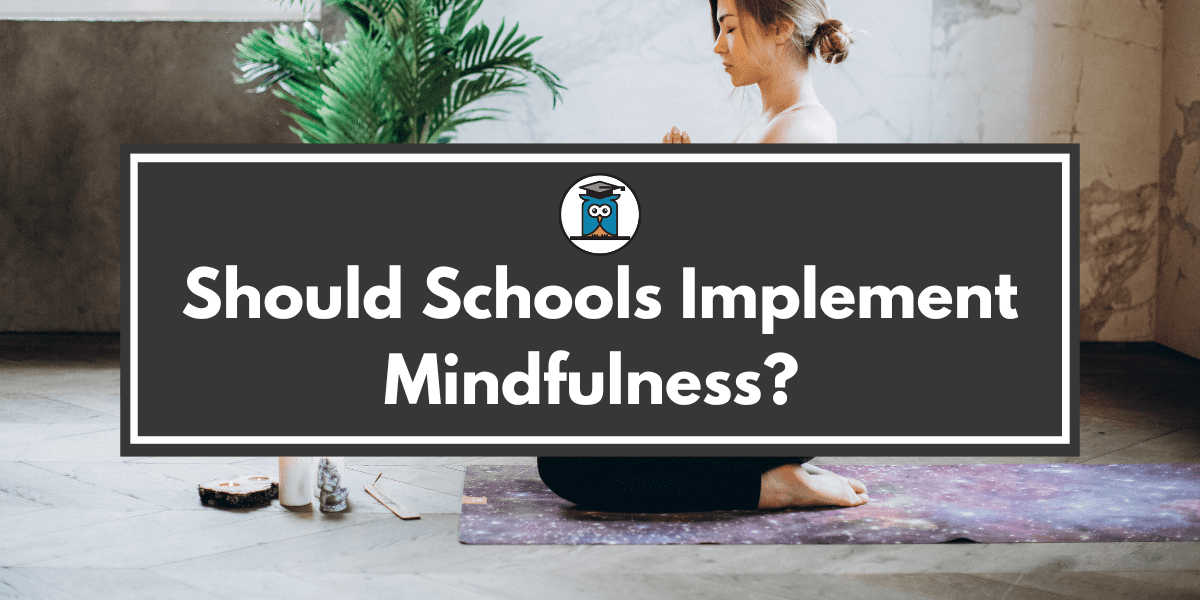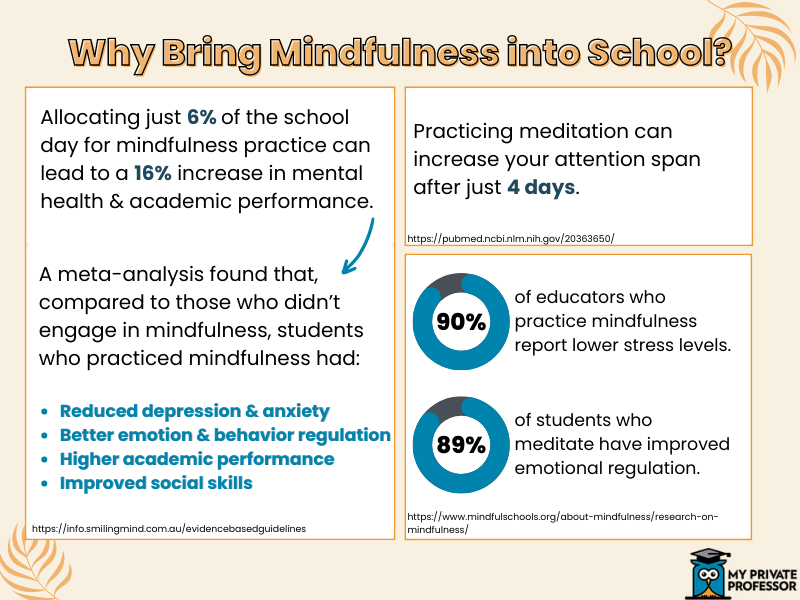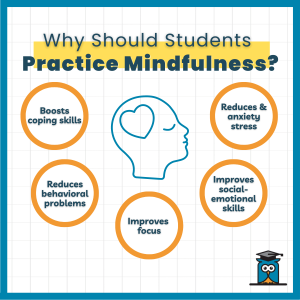Mindfulness—is it something, like setting multiple alarms, that students should practice daily?
Although mindfulness may seem like a fad that’s rooted in pseudoscience and the school of pop psychology, research says otherwise.
What is mindfulness?
Mindfulness is the practice of showing awareness to your thoughts, feelings, and sensations—and doing so without judgment. When you practice mindfulness, you empower yourself to be accepting rather than reactive.
This may sound pretty simple, but the results can significantly change our outlook and outcomes in life.
While mindfulness goes hand-in-hand with awareness, it’s a gentle, non-judgemental awareness. So rather than scrutinizing, you’re observing. Once you develop a mindfulness practice, you can learn to be more present in what you’re doing—and thus more focused and productive.
Some history behind mindfulness
Mindfulness originated as a practice in Hinduism and Buddhism cultures; and for centuries, people have been utilizing it as a calming technique. “Mindfulness” originated from the Buddhist concept, “Sati,” which refers to the awareness of present events.
In the 20th century, psychologists began using the technique to treat disorders such as depression and anxiety.
Should schools implement mindfulness?
A student’s daily life may bring with it moments of stress, panic, fear, doubt, or confusion. And when this happens, their whole day may turn upside down. We’ve all been there.
You get a math test back—and suddenly the entire day is pointless. Or, you humiliate yourself in front of the whole class.
The point is, whether you like it or not, school and angst often fit together like two puzzle pieces.
Often, when students find themselves in a moment of stress, it’s difficult for them to get back to reality. Stress can spiral and make anyone think that their life is crumbling. And then, it’s incredibly difficult to figure out how to stop procrastinating all of your homework, studying, and projects.
That’s where mindfulness comes in.
Nowadays, we’re often on the go—all the time. But not only physically. Research has actually found that—partially due to technology’s continual developments—we are increasingly losing the ability to focus. Before we get the chance to have a moment of stillness or reflection, we tend to already be moving onto the next thing.
What are the consequences here?
First of all, constantly switching between tasks only speeds up your declining focus—and being able to focus goes hand-in-hand with performing well in school.
But also, when you’re always doing something, you don’t provide yourself with that you time—that time where you can check in with yourself. And if you never give yourself the opportunity to do mental checks, you’ll find it quite difficult to feel internally grounded.
How mindfulness works
You’ve likely heard of the fight or flight response.
The fight or flight response refers to what we do in a situation that stimulates stress and puts us into a state of “threat”. When in this state, your nervous system essentially prepares your body to make one of two choices: fight or flee.
When you practice mindfulness, you can train your brain to combat this initial reaction and instead, simply observe your state of mind, then move on.
Through using fMRI, scientists have demonstrated that mindfulness can reduce activity in the amygdala (which manages fear responses) and increase neuron density in the prefrontal cortex—a key player in regulating emotions. What this means is that the reactive/fear region weakens, while the emotional regulator region grows.
Basically: mindfulness can reduce your reactive, fearful response, and strengthen your thoughtful response.
Students are struggling – and mindfulness can help
According to APA, prior to the pandemic, the depression rate for K-12 students was already on the rise. And as you might assume, the pandemic only heightened student mental health issues.
- As of 2020, 12% of U.S. children experience anxiety or depression—an increase from 9% in 2016.
- Around 35% of American children experience stress-related physical issues.
- From March 2020 – October 2020, mental-health related visits to the ER increased by 24% for children ages 5-11 and by 31% for children ages 12-17.
And, according to a WebMD study, the child’s home environment is a leading cause of stress for kids. If the child’s home is bringing them stress, shouldn’t their other main environment, school, help students confront these issues?
So, how can mindfulness be especially effective for students?
By guiding students to staying present in any given situation, mindfulness can teach students how to be more productive workers, identify more realistic goals, and develop more valuable relationships.
Reduces stress and anxiety
In a meta-analysis of more than 200 studies on the effect of mindfulness, researchers found that mindfulness-based therapy was particularly impactful for reducing stress, anxiety, and depression.
When students hold less stress and anxiety, they’re better able to focus, be productive, and achieve their goals.
The thing is, experiencing stress often goes hand-in-hand with performance declines. And a major reason for these declines is that stress causes us to increase our mind wandering.
Mind wandering refers to when your thoughts do not remain attached to the events around you, but instead move toward different topics and/or tasks. Deliberate daydreaming can actually be a good thing and can help stimulate creativity and gratitude. But when it consistently occurs unintentionally, it’s often associated with stressful situations or events.
So here we have a cycle. First, you get stressed. Then, you engage in mind wandering. The result? Declines in academic performance—which can lead to more stress. And thus the cycle continues.
Researchers with the Boston Charter Research Collaborative conducted a study focusing on sixth graders in Boston (2019). The study found that students who participated in an eight-week mindfulness program were less stressed than students who didn’t participate.
Using mindfulness to combat stress, students can learn how to better regulate their stress and as a result, see improvements in performance. On top of this, by utilizing mindfulness to reduce stress, students can empower themselves to reduce stress-related burnout.
And when you reduce stress, you’re not doing just that. Stress is related to sleep issues, immune system, motivation, and low self-esteem. So by lowering stress, you indirectly start to confront all of these other issues.
Improves focus and attention
If you constantly find yourself mind wandering, it seems likely that you’ll have performance declines. And as mentioned above, this can lead to increased stress.
Luckily, there’s an antidote for a wandering mind: mindfulness.
You can think of mind wandering as the butterfly—flitting from flower to flower, and never stopping for a long time. And then the mindful mind is the sloth—remaining still for long periods of time, observing the environment around them.
By training your mind to be more like the sloth, you’ll learn to be more tuned in to the present moment. And as a result, you’ll boost your attention span, and then ultimately improve your academic success.
Boosts emotional intelligence
One paper analyzing ten studies on the relationship between mindfulness and emotional intelligence found that mindfulness is a key player in developing the ability to regulate emotions.
By now, you know that mindfulness helps you feel more present in the moment. Well, with any given moment comes any given emotion(s). So when you develop mindfulness, you become more capable of identifying certain emotions, and recognizing how they’re affecting you.
Moreover, with a greater capacity for emotional intelligence, you can more effectively engage with others, show empathy, and have meaningful relationships.
In the study with the Boston Charter Research Collaborative mentioned earlier, the researchers measured some of the students’ brains. They found that, for students in the mindfulness program, the amygdala responded to fewer fearful faces than they did prior to participating in the program.
This is important because it suggests that their brains were less sensitive to negative stimuli; and thus, they were more likely to get stressed out.
How to implement mindfulness at school
First, start with the teachers.
In order to successfully implement mindfulness teaching at school, you must start with the teachers. It will be very valuable to provide teachers with a mindfulness program or training so that they themselves can feel more competent implementing it into their classrooms.
Then, brainstorm different ways to adopt mindfulness in the classroom.
This is the fun part. It’s time to shake things up and bring something new into the classroom—and there are so many ways to do this.
Here are a few ideas to consider:
- Mindful eating – set aside a time during lunch or snack time where students engage in mindful eating. Here, the goal is for students to notice all of the different sensations they experience. To make this easier, encourage students to discuss or write down all of the sensations they felt afterward.
- Mini meditation – students often struggle with focusing for long periods of time, so implementing mini mindfulness is a great way to dip one foot in.
- Body scans – allocate time for body scans, where students get to take stock of their entire present state. During this time, instruct students to either sit at their desks or lie on the floor and guide them to walk through paying attention to their body by noticing sensations all the way from their toes up to their head. Encourage them to observe any sensations or emotions that any given body part brings—and then move onto the next.
Questions to ask during a body scan:
- How does [x body part] feel?
- Is it tense or relaxed?
- Do you feel pain?
- Is [x body part] warm or cold?
Final thoughts
When you practice mindfulness to improve your internal wellbeing, the external factors in your life will reflect that change.
For instance, once you’re feeling more focused and present, you’ll have better luck acing that geometry test. When you’ve discovered how to regulate your emotions better, you’ll be better suited to give that hour-long presentation in front of the class. And when you’ve shedded some of that stress that’s been hanging over your head, you’ll be more able to engage in meaningful conversations and interactions.
While you may feel as though that constant, on-the-go life, filled with stressors, is a hurdle between you and your happiness, there’s a way over the hurdle.
“Mindfulness gives you time. Time gives you choices. Choices, skillfully made, lead to freedom.”
– Bhante Henepola Gunaratana









